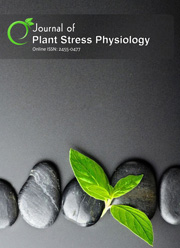Growth and yield performance of Sponge Gourd (Luffa cylindrica) under different doses of nitrogen fertilizer
DOI:
https://doi.org/10.25081/jpsp.2023.v9.8697Keywords:
Luffa cylindrica, Nitrogen, Growth and yieldAbstract
An experiment was carried out at a farmer’s field in Nowpara village, Trishal upazila, Mymensingh from 3rd May 2023 to 15th September 2023 to find out the effects of nitrogen (urea) fertilizers on the growth and yield performance of sponge gourd. The field experiment was arranged using a randomized complete block design with local variety Fujian F1 with four treatments and three replications viz. (Urea) T1: Control (0 kg N/ha), T2: 25 kg N/ha, T3: 50 kg/ha, T4: 75 kg N/ha were used for the present study with three replications. In treatment T4, the tallest sponge gourd plant was 123.5 cm, while in treatment T3, it measured 112.5 cm. For treatment T1, the smallest plant measured 61.33 cm. In terms of leaf numbers, treatment T4 had the greatest number of leaves 63 while treatment T1 had the lowest number of leaves 30. The highest diameter of the leaf measured was 13.05 cm in T4 and the lowest diameter found was 6.8 cm in T1. Out of the four treatments, treatment T4 had the tallest leaves, measuring 12.73 cm, followed by treatment T3, which had leaves measuring 9.7 cm. In T1 and T2, the smallest leaf lengths were found to be 6.7 and 7.8 cm, respectively. The tallest length of the petiole found was 7.8 cm in T4 and the smallest length of the petiole recorded was 5.5 cm for the treatment T1. The longest fruit measured from T4 was 28.33 cm, while the tiniest fruit came from T1 and measured 18.6 cm. The treatment T4 had the highest fruit weight, measuring 227 g, while treatment T3 had a weight of 176 g. The minimum weight was 93 g found in T1. Treatment T2 has shown the weight of the fruit those were 134 g.
Downloads
References
Ali, I., & Ali, A. (2011). Effect of N levels and sowing methods on the growth and yield of swiss chard cv. kalam selection. International Research Journal of Plant Science, 2(7), 209-214.
FAO. (1988). Land Resources Appraisal of Bangladesh for Agricultural Development. Report 2. Agro-ecological Regions of Bangladesh. Rome: United Nations Development Program, Food and Agriculture Organization of the United Nations.
Hashan, M. N., Mahmud, R., Sizan, M. J. M., Tanim, K. M. Y., Das, B., Khan, R. N. A., & Hoshain, S. (2023). Effect of different doses of nitrogen fertilizer (urea) on the yield performance of mustard (Brassica sp.). Research in Agriculture Livestock and Fisheries, 10(2), 99-107. https://doi.org/10.3329/ralf.v10i2.68753
Leghari, M. H., Mugheri, A. A., Sheikh, S. A., & Wahocho, N. A. (2014). Response of nitrogen levels on the growth and yield of bottle gourd varieties. International Journal of Agronomy and Agricultural Research, 5(6), 86-92.
Mazali, I. O., & Alves, O. L. (2005). Morphosynthesis: High fidelity inorganic replica of the fibrous network of loofa sponge (Luffa cylindrica). Anais da Academia Brasileira de Ciencias, 77(1), 25-31. https://doi.org/10.1590/S0001-37652005000100003
Nurrohman, E., Zubaidah, S., & Kuswantoro, H. (2018). Effect of Nitrogen Dosage (N) on Morphology of Soybean Strains (Glycine max (L.) Merr) Hold Bemisia tabaci. Bioedukasi Universitas Jember, 15(2), 13-17.
Oboh, I. O., & Aluyor, E. O. (2009). Luffa cylindrical - An emerging cash crop. African Journal of Agricultural Research, 4(8), 684-688.
Olaniyi, J. O., Adelasoye, K. A., & Jegede, C. O. (2008). Influence of nitrogen fertilizer on the growth, yield and quality of grain amaranth varieties. World Journal of Agricultural Sciences, 4(4), 506-513.
Partap, S., Kumar, A., Sharma, N. K., & Jha, K. K. (2012). Luffa Cylindrica: An important medicinal plant. Journal of Natural Product and Plant Resources, 2(1), 127-134.
Prasad, P. H., Mandal, A. R., Sarkar, A., Thapa, U., & Maity, T. K. (2009). Effect of biofertilizers and nitrogen on growth and yield attributes of bitter gourd (Momordica charantia L). International Conference on Horticulture (pp. 738-740).
Siyag, S., & Arora, S. K. (1988). Effect of Nitrogen and phosphorus on fruit yield and quality of sponge gourd (Luffa aegyptiaca). Indian Journal of Agricultural Sciences, 58(11), 860-861
Solangi, A. H., Baloch, J. A., & Iqbal, M. Z. (2009). Effect of vertical trailing on vegetative, reproductive and yield of Luffa as intercrop in coconut field. Pakistan Journal of Botany, 41(5), 2537-2541.
Zohura, F. T., Haque, M. E., Islam, M. A., Khalekuzzaman, M., & Sikdar, B. (2013). Establishment of efficient in vitro regeneration system of ridge gourd (Luffa acutangula L. Roxb) from immature embryo and cotyledon explants. International Journal of Scientific and Technology Research, 2(9), 33-37.
Published
How to Cite
Issue
Section
Copyright (c) 2024 Journal of Plant Stress Physiology

This work is licensed under a Creative Commons Attribution 4.0 International License.



 .
.